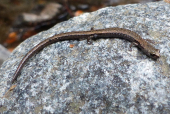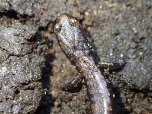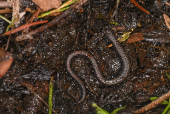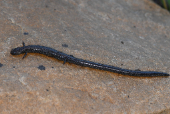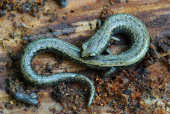Greenhorn Mountains Slender Salamander (B. altasierrae)
Description: Adults are 1 3/8 to 1 7/8 inches long from snout to vent. A small slim salamander with 16 to 20 costal grooves. Short limbs, a narrow head, long slender body, very long tail, and conspicuous costal and caudal grooves give this species the worm-like appearance typical of most Slender Salamanders. There are four toes on the front and hind feet, which is also typical of Slender Salamanders. (Other California salamanders have five toes on the hind feet.) Color is blackish brown with a reddish, yellowish, or dark brown dorsal stripe which is often not visible in large animals.
Habitat: Occurs in heavily forested areas of mixed conifers and deciduous oaks. Associated with seepages and springs which remain moist through the summer.
Range: Endemic to California. B. altasierrae is the common high elevation Batrachoseps species found on the western slopes of the southern Sierra Nevada. Occurs in the Greenhorn Mountains north to the Tule River and Kern River highland drainages. It is also known from one area on the western edge of the Kern Plateau east of the Kern River.
Found in these States:
CA
Diet: Most likely eats a variety of small invertebrates. Feeding behavior is not well known, but other Batrachoseps species are sit-and-wait predators that use a projectile tongue to catch prey.
Reproduction: Little is known about the breeding behavior of this species. Reproduction is terrestrial. Breeding and egg-laying probably occurs during the rainy period from November to January. All species of Slender Salamanders lay eggs, typically in moist places on land. Young hatch fully formed.
Status: The species' extent of occurrence (EOO) is 1,483 km2 and there is a degree of continuing decline in the extent and quality of surrounding habitat. However, it predominantly occurs in protected areas, its population is suspected to be stable at present, its population is probably not severely fragmented, hence it is listed as Near Threatened because it is close to qualifying for Vulnerable under criterion B1.
»» Kingdom: Animalia - Animals
»» Phylum: Chordata - Chordates
»» Subphylum: Vertebrata - Vertebrates
»» Class: Amphibia - (Amphibians)
»» Order: Caudata - Salamanders
»» Family: Plethodontidae - Lungless Salamanders
»» Genus: Batrachoseps
»» Species: B. altasierrae - Greenhorn Mountains Slender Salamander
This article uses material from the Wikipedia article "Relictual slender salamander", which is released under the Creative Commons Attribution-Share-Alike License 3.0. Content may have been omitted from the original, but no content has been changed or extended.
|




